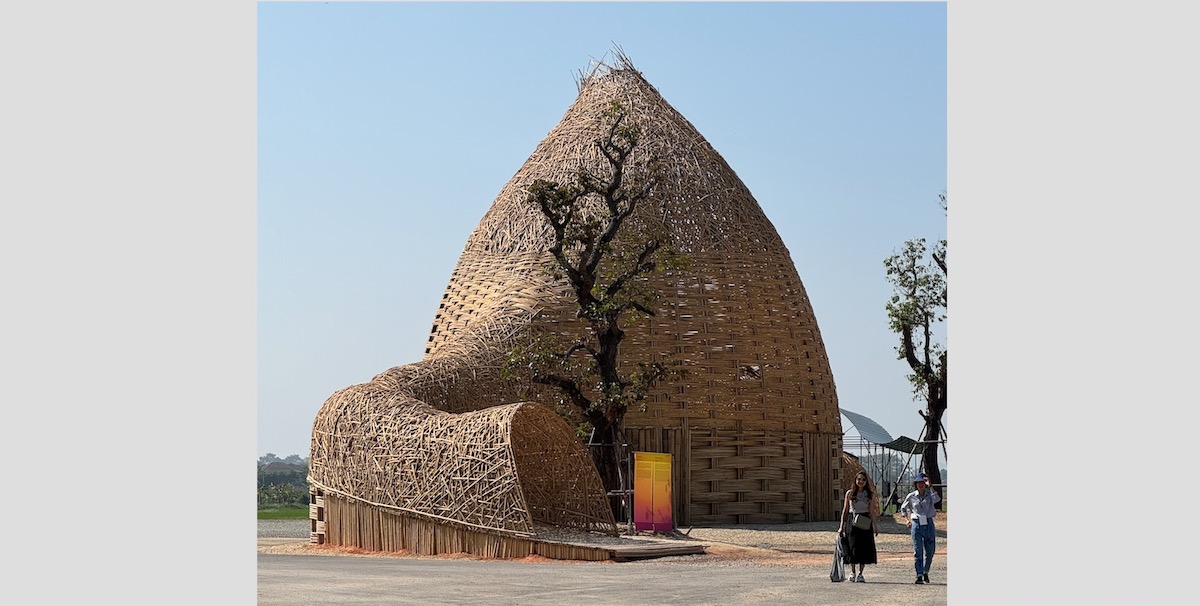Visiting the Thailand Biennale in early February was an immensely rewarding experience. The third iteration of this travelling art event is being held in Chiang Rai and its surrounding areas from December 9, 2023, to April 30, 2024. Visiting in the early months of the year is ideal for exploring the region of the north known as the Golden Triangle, which borders Laos and Myanmar and is near China and Vietnam. While only Laos and Myanmar directly border Thailand, the area is a confluence of diverse historical, artisanal, and cultural heritages.
At the Biennale, 60 artists—among whom are notable international figures such as Haegue Yang, Sarah Sze, Tobias Rehberger, and Pierre Huyghe—from 21 countries are showcasing their work. The event is abuzz with various activities: traditional music concerts, performing arts, film showings, educational workshops, and 13 pavilions; moreover, over 80 local artists are opening their homes to the public.
The theme “Open World” fittingly reflects the ethos of the Biennale: fostering a conversation between the local traditions of Northern Thailand and contemporary global issues, all while embracing Buddhist principles with a keen interest in architecture and spatial design. Co-Artistic Directors Rirkrit Tiravanija and Gridthiya Gaweewong, as well as Co-Curators Angkrit Ajchariyasophon and Manuporn Luengaram, have taken inspiration from the welcoming pose of the Buddha statue at the serene Wat Pa Sak temple, encouraging an open-hearted approach to the world. This sentiment resonates with the contemporary art dialogue surrounding topics like history, ethnicity, migration, and ecological crises.

Photo credit: Virginie Puertolas-Syn
My adventure commenced at the Chiang Rai Tobacco Warehouse, where a vibrant, colourful mural by Ghanaian artist Atta Kwami welcomed patrons, paying tribute to Ghanaian architectural and textile traditions. Inside, Tomás Saraceno presented a version of his “Museo Aero Solar,” an aerosculpture fashioned from recycled plastic bags—a statement of his blend of art and science. The new Chiang Rai Museum of Contemporary Art, surrounded by rice paddies, displayed magnificent outdoor sculptures, including a bamboo piece by Taiwanese artist Wang Wen-Chih. Its majesty lies in its aesthetics and representation of a profound collaboration between Taiwanese artisans and local craftspeople of Chiang Rai, celebrating traditional architecture.

Photo credit: Virginie Syn
The Cherntawan International Meditation Center, nestled within a lush park, was adorned with large-scale installations by Thai artists like Korakot Aromdee and Chata Maiwong. Notably, ‘Garden of Silence’ by Chelsea-educated artist Sanitas Pradittasnee consisted of three installations that blended seamlessly with the 108 surrounding rubber trees. Her work was captivating through its interaction with the space and its expression of tranquillity and simplicity.
Another compelling installation, ‘Belief is like the Wind’ by Arin Rungjang, included the voice of a Pgakenyaw woman from the hill tribes, creating a shamanistic link to the land and its inhabitants. Tucked away in the idyllic Mae Luang Art Center, with its banyan trees and lotus ponds, was Ernesto Neto’s piece, which was a natural extension of the scenery, utilising spices and materials from Chiang Rai. An auditory piece by Vietnamese artist Nguyen Trinh Thi, located in a grand wooden temple, played the ambient sounds of the Mekong River. Japanese artist Ryusei Kido and local craftsman Kamjan Yano carved a rice barn, culminating in the ethereal sculpture “Inner Light”, which celebrated light and reflected Buddhist teachings challenging the notion of intrinsic existence or permanence.
Further north, near the Laos border at the Chang Warehouse, the paintings of Sawangwongse Yawnghwe, who hails from the royal Shan family, depicted a vivid narrative of indigenous opium culture and its impact on local ecosystems.
The journey’s finale brought me to an abandoned school at the northernmost site, where acclaimed artist and filmmaker Apichatpong Weerasethakul explored the concept of temporality. His use of traditional Thai folk opera elements and evocative installation, reminiscent of bygone meditative practices, was entrancing.
My three-day expedition through the Biennale was much more than an artistic journey. It was a spiritual pilgrimage rooted in Buddhist values, prompting reflection on existence and the void. The natural beauty of Chiang Rai fostered a profound conversation between the art installations and their surroundings. Numerous artists created site-specific works, cultivating a symbiotic relationship between the artist and the space—a hallmark of a resonant Biennale.
Leaving the Biennale, I felt utterly captivated and couldn’t help but see the connections to the upcoming Venice Biennale, themed “Foreigners Everywhere.” In a world that seems increasingly divided, the Biennale’s overarching message is one of openness towards others and the larger world, illustrating the role of art as a connective force among people.
May the Buddha from Wat Pa Sak guide us in disseminating and sharing his universal message of wisdom and awareness.
Thailand Biennale The Open World 9 December 2023 – 30 April 2024
Visit Here
Words and Photos: Virginie Syn ©Artlyst 2024

